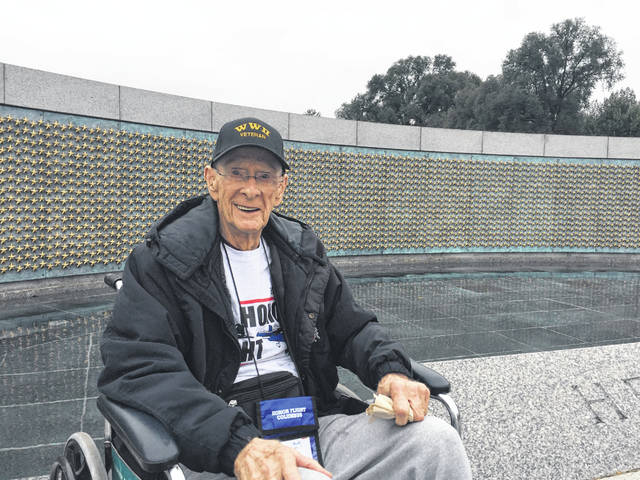
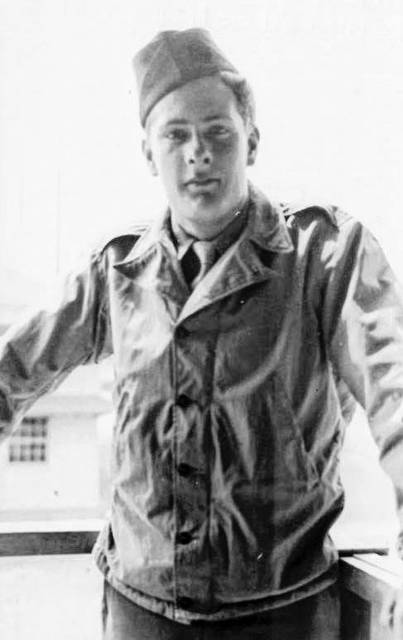
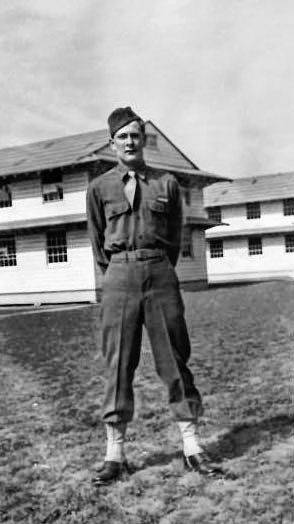
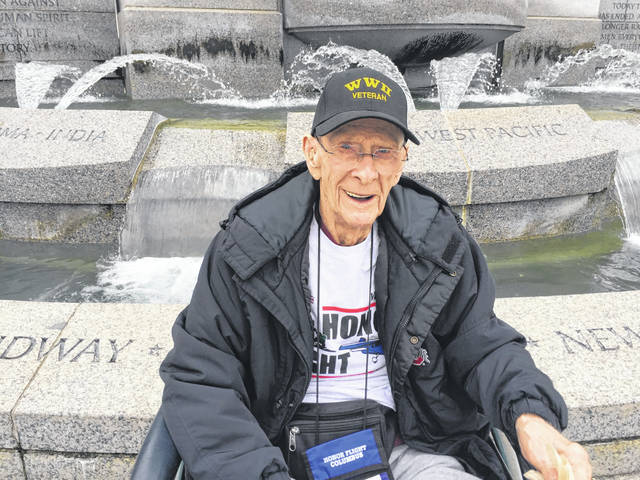
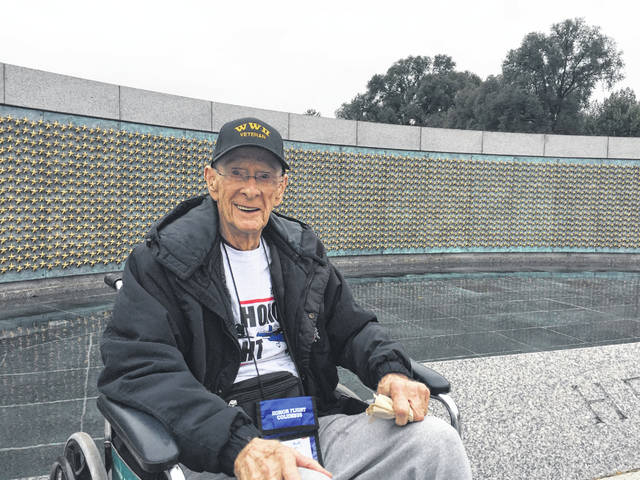
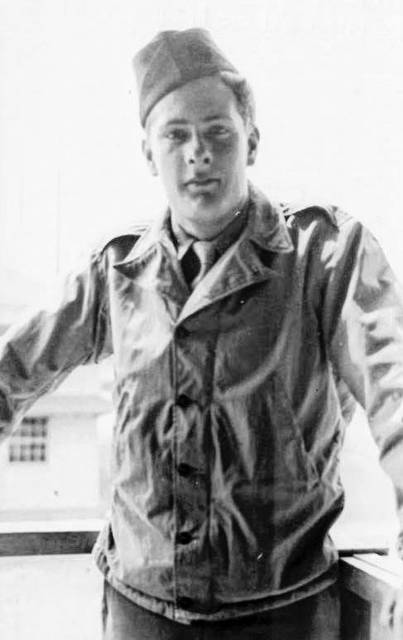
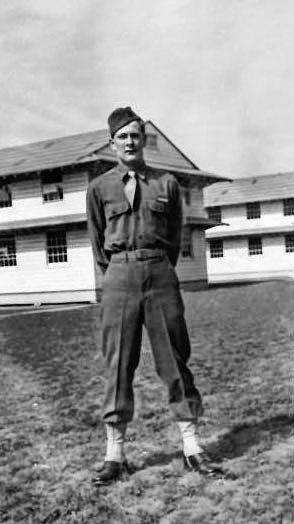
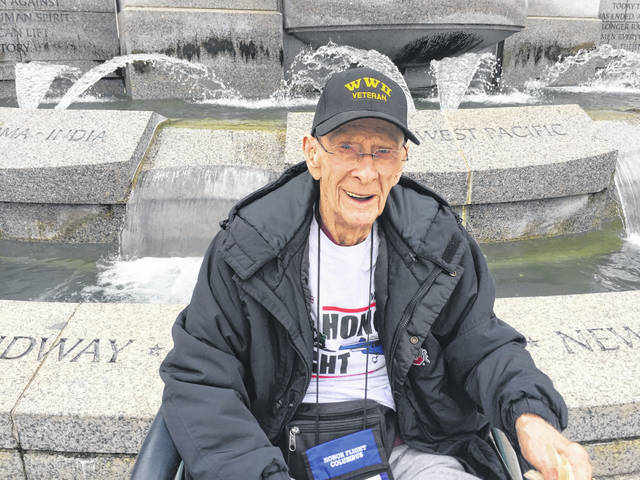
When longtime news anchor Tom Brokaw famously coined the term “Greatest Generation” to describe the men and women of the United States who grew up during the Great Depression and helped the Allies save the world during World War II, he was referring to Americans like Delaware resident Lee Siegwald.
At the ripe old age of 95, Siegwald isn’t shy about sharing his life story with anyone willing to sit down and visit with him at Willow Brook Christian Village.
“Right now, I’m in the part of my life where (family and stories) is about all I have,” Siegwald said. “Memories is what it is all about.”
Those memories, like many others of the “Greatest Generation,” include challenging economic times, marrying his high school sweetheart and raising a family, serving his country abroad, and growing old in a country he loves and was willing to die protecting.
“I’m just built differently,” Siegwald said.
Born and raised in Circleville, Siegwald had just graduated from high school when he decided it was time to face a new challenge — enlisting in the military with hopes of becoming a pilot, but not just any pilot.
“I wanted to be a hot pilot,” he recalled. “All young guys wanted to be hot pilots, so I tried to enlist in the Air Corps.”
After passing his initial test, Siegwald was a medical test away from becoming a “hot pilot.”
“My teeth kept me from being a hot pilot,” he said. “I only had 32 fillings to be done, and I didn’t figure I could pay for those or even have those done, so I waited to be drafted.”
Siegwald didn’t have to wait long to get the call to serve his country as a year later on Jan. 8, 1943 — his 20th birthday — he was drafted into the U.S. Army, an opportunity he relished, despite knowing there was a chance he could lose his life on a battlefield in some distant land.
“Here’s the big deal and most people nowadays won’t understand this, but the culture of this country was different in 1941,” Siegwald said. “When we declared war, it was like the whole country said that is okay, that is what we will do, and we will be behind it.
“We didn’t have people socking one another in the face or shooting one another. It was a combined great cultural feeling of we will unite and get this done. I’m trying to purvey that to the generations to come, because we are not there today like that,” he said.
Siegwald added he isn’t “too happy with what is going on” in the country right now, but giving up on his country and fellow Americans isn’t something he’s willing to do.
“I could easily say, ‘So what, I’m ready to die.’ But I’m not,” he said. “I want to see what the young people can do.”
Military roles
When asked about his time in the U.S. Army, Siegwald said he was, among other things, a drill sergeant. To this day, he said it was a role he was born to do.
“I got a big mouth and hard body, but I have a weak spine,” he said. “I love everybody. I really do, except for the people I don’t like.”
While some of his fondest memories were those days spent as a drill sergeant, Siegwald and many others at that time were focused on one main goal — helping the Allied Powers win the war. With that in mind, Siegwald made the decision to go to Officer Candidate School (OCS), which led him to becoming part of the U.S. Army Ordnance Department.
For those unfamiliar with this particular department, Siegwald said that’s understandable.
“A lot of people don’t know what it is,” he said. “I didn’t know when I was sent to Aberdeen (Maryland) what the hell ordnance was either. I thought maybe it was a tin can or something.”
Siegwald soon found out the importance of the Army Ordnance Department as he found himself helping troops battle the Axis Powers in the Philippines.
“With the Army, we planned, developed, tested, produced, supplied, and maintained all the personnel equipment that you can think of — ammunition, arms, tanks … just anything you can think of.”
For instance, Siegwald said while on the ground, airplanes would drop numerous supply boxes in a particular area. Thanks to a complex identification system ran by the ordnance department, the supplies made it to the correct divisions.
“If the engineers, air force or infantry needed ammunition, they didn’t have to break down a thousand crates looking for it,” he said.
Thanks to Siegwald and his crew, troops on the ground knew where to go to get the essentials they needed, assuming they had the proper clearance.
“You had to order it,” he said. “You couldn’t go and pick a gun out of the warehouse. You had to write a requisition, and a captain had to sign it and all that crap. Same crap in the Army as it is in the civilian life.
“I have a code that I did go by in the Army: ‘I’ve never seen so much inefficiency so well organized.’ That’s the ordnance department,” he added.
Near-death experiences
When recalling some of the unforgettable moments he experienced while serving his country in places like New Guinea, the Philippines, and Japan during World War II, Siegwald said while he was shot at from time to time, he never had to dodge “machine-gun fire” like many of his fellow countrymen. He did, however, have a few hair-raising situations, including a freak accident onboard a ship and walking away from a two-story fall.
Siegwald vividly described an incident that occurred while he was onboard a large ship in the Admiralty Islands with 2,000 to 3,000 other servicemen.
While the ship was resting in a bay, Siegwald and the others were treated to a “beautiful buzz job by an American pilot who was simply showing off, which didn’t set well with the ship’s commander.
“The Navy pilot came back 15 minutes later with his buddy,” Siegwald said. “Man he gave us a real buzz job. I’m up on the top deck with about 2,000 others and that guy looked like he was going to come right into the side of the ship.”
After two to three passes, that’s exactly what happened.
“The last pass he was flying along and turns the plane upside down,” Siegwald said. “He makes a turn back toward the ship upside down and I thought, ‘What the hell is he doing. He is not going to be able to right that plane and swoop up and miss us, he’s going right through the ship.’ That’s exactly what he did.”
Siegwald said the impact killed not only both men in the plane, but 13 Navy men sleeping on the ship.
“He went right below me,” Siegwald said. “I’d say 10 feet below where I was standing was a hole in the side of the ship.”
He added it was pure luck that only a dozen-plus men were killed that day. Had the plane crashed just feet higher, the death toll would have included many men, Siegwald one of them.
The crash, he added, occurred simply because the pilot wanted to “show off.”
“You can’t imagine what people did to show off. It’s unbelievable,” Siegwald said.
While he dodged injury during the aircraft mishap, the same can’t be said about an incident that occurred while Siegwald was with his crew in Manila, Philippines.
In search of a building to house all the ordnance department equipment, the group can upon a bombed out old shoe factory.
“It was an open building, because it had been bombed out, so we had to put a roof on it,” Siegwald said. “I was up there (on the roof) sort of supervising … and they had a plank up there where we would walk since the sheet metal roofing wouldn’t support you. I just literally forgot where I was, and I didn’t step on that plank. I fell probably 20 feet through the roof and hit the concrete.”
Fortunately for Siegwald, someone was looking out for him that day.
“Don’t ask me how I didn’t hurt my head or my tailbone,” he said. “The only thing it did was break a bone in my hand. I was laid up in the hospital for a while, but I couldn’t believe how I came out of it.”
While Siegwald is thankful he survived his time overseas during WWII, he will never forget the men who didn’t make it back, some of which he knew personally.
“I’ve been shot at, but luckily, I was never in the position where a machine gun was trying to get me like the guys who were in Normandy,” he said. “Those kids were 17, 18 and 19 years old. That could have been any one of us.”
Transitioning from military to civilian life
Like so many men of his generation, Delaware resident Lee Siegwald returned home from the war and sought to live his own American dream.
For Siegwald, that was spending time with his wife, raising children, and working hard for everything he had.
It wasn’t an easy transition from military life to civilian life for Siegwald, who returned to Ohio to a life with his high school sweetheart, Mary Ruth, whom he married while he was in the service.
“We were married on Feb. 19, 1944, in a chapel on the Army post in Aberdeen, Maryland, while I was a drill sergeant,” Siegwald said.
Once he returned to the States, finding a job was difficult, so he decided to put his G.I. Bill to use.
“I was unemployed for a long time,” Siegwald said. “We started having kids, and I thought I’d better get an education.”
The Ohio State University was his first choice, but the experience was one Siegwald wishes would have gone a different way.
“I made my biggest mistake of my life at the university,” Siegwald said. “At that time, Ohio State University was not ready for one million returning servicemen to come to school free.”
Siegwald said when he enrolled, class sizes were in the hundreds, which made it difficult for students and the university to make schedules work.
“I tried to get a schedule to fit what I needed to do, which was get a job since I had a child on the way,” he said.
Siegwald said at that time in his life, he was hitch-hiking from Circleville to Columbus and really needed a class schedule that didn’t include Saturday classes as that would have cut into his work hours.
“The gal that was in charge of setting up the classes said, ‘I can’t help you,’” Siegwald recalled. “I was angry. I told her she could take this university and stick it where the sun don’t shine.”
With OSU out of the picture, Siegwald turned to Franklin University, where he received a degree in architectural drafting.
With degree in hand, the family moved from Circleville to Dominion Boulevard in Columbus, where Siegwald would remain for 73 years until moving in May to Willow Brook Christian Village in Delaware.
While living in Columbus, Siegwald worked as a carpenter and a jack-of-all-trades before entering the building business.
As for what he considers his most important job — being a family man — Siegwald and his wife raised five children before she passed away from breast cancer in 1985 at the age of 65.
Still “angry” at the disease that took his beloved wife, Siegwald is hopeful a cure will one day be found that might save the life of someone in his family, which includes 12 grandchildren and a number of great-grandchildren.
“They all know who the patriarch is,” Siegwald said with a chuckle.
No matter what the rest of his life has in store, Siegwald said he’s thankful for the first 95 years of his life, a life that included his generation rising up in the face of adversity. By the grace of God, Siegwald added, his life was spared during WWII, allowing him to spend four decades with his wife, raise five kids, and spend time with his grandchildren and great-grandchildren.
“I thank God every day,” he said. “I wonder how many of us WWII guys are left. There is not a hell of a lot of us left, really.”





